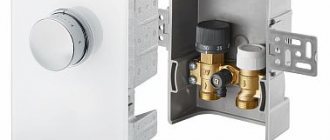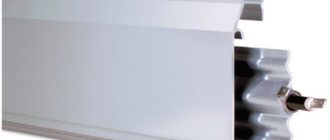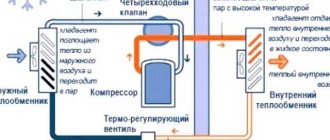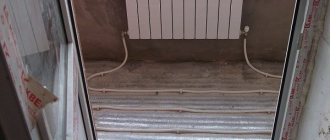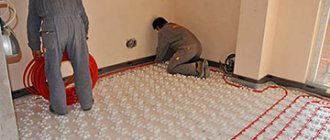A cozy and dry house is the dream of every owner. To achieve maximum comfort, people use modern solutions, one of which is electric warm baseboards. It is used:
- Paired with a central heating system to provide an additional heat source;
- As an independent heating device capable of heating a small private house or cottage.
Installing a warm baseboard is simpler than installing a radiator, less expensive, and the design looks appropriate in any room. New modern equipment will become not only a source of heat in the house, but also an original addition to the interior.
Peculiarities
A novelty in the form of electric warm baseboards entered the Russian market relatively recently and still remains an unusual and innovative heating method, indispensable in some situations:
- In many country villages and gardening communities there is still no gas, so houses with stove or electric heating are popular. The stove creates comfort in the house, the fuel for it is produced by the owners and is inexpensive, but the stoves require maintenance: periodic cleaning, regular heating, preparation of firewood, and storage. Electric heating devices turn on and heat up in just a few minutes, require virtually no maintenance and a separate room for storing fuel;
- In houses with panoramic windows, installing a classic radiator with liquid coolant is impossible or will greatly spoil the appearance of the room. Warm skirting boards are invisible in the interior and easily fit into any room;
- In apartments or houses where a heating system is already installed, the electric baseboard will serve as an additional source of heat. Installing this device costs much less than modifying an existing heating system.
Pros and cons of electric skirting boards
Electric warm baseboards have both their pros and cons. For example, unlike radiators, it does not work on the convection principle, so air flows in the room do not actively circulate. As a result, zones of unstable temperature conditions in the room disappear, and it begins to warm up evenly.
A warm baseboard can show the greatest efficiency during its operation when used in rooms that have high ceilings and a large number of windows.
In addition, this heating system can be used on balconies. This is due to the fact that this device can simultaneously heat the floor and walls, which eliminates the possibility of mold and mildew in the room. Other heating systems do not have this effect.
If you install a warm electric baseboard yourself, you can get additional savings
As for the question of how much a warm baseboard costs, it usually has a price in the region of 870-1500 rubles per meter. At the same time, if you install a warm electric baseboard yourself, you can get additional savings. This heating system is affordable for most people.
Important! A warm baseboard can show its greatest efficiency during its operation when used in rooms that have high ceilings and a large number of windows.
It also performed well in rooms with an arched or wide entrance. This is due to the ability of a warm baseboard to create a thermal curtain.
The plinth fits perfectly into any interior and can be done discreetly
In addition, such a heating system allows you to quickly adjust the temperature regime of the room. At the same time, the plinth fits perfectly into any interior and can be done discreetly. It is compatible with underfloor heating, does not dry out the air in the room and can be easily installed and dismantled on site.
During the installation of electric baseboards, it will be necessary to consult a specialist in order not to disturb the uniform heat transfer in the room
As for the disadvantages of this method of additional heating, during installation of the electric baseboard it will be necessary to consult a specialist in order not to disrupt the uniform heat transfer in the room. Also, the device can damage the wallpaper in the places where it is attached, and the covers on it have a limited choice of colors.
If everything is in order with your finances, choosing a warm baseboard will be an ideal option for installing an additional heating system in the room
Well, perhaps the main disadvantage of an electric warm baseboard is the fact that it has a high level of energy consumption. As a result, its active use can create a fairly serious hole in your budget. This is also worth keeping in mind when installing it in your home. If everything is in order with your finances, choosing a warm baseboard will be an ideal option for installing an additional heating system in the room.
The warm baseboard is compatible with heated floors, does not dry out the air in the room and can be easily installed and dismantled on site
Principle of operation
Before choosing a heating device, you need to understand the principle of its operation.
Externally, the electric baseboard is a metal strip, approximately 3 cm wide. The height ranges from 10 to 25 cm. The device is installed around the perimeter of the room immediately above the floor, it is as inconspicuous as possible and can heat the room without attracting undue attention.
The color, shape and texture of the planks are chosen depending on the interior of the room or are made to order. The body is made of aluminum or bimetal - materials resistant to heat and mechanical stress. The quality of the electric skirting board affects its durability and efficiency.
The main element of the device is a tubular electric heater (TEH), which occupies the entire internal space of the metal strip.
The principle of operation of electric heated baseboards is similar to the principle of operation of heated floors:
- Once switched on, electricity passing through high resistance elements soon heats them up;
- As a result, the air near the baseboards is heated due to heat exchange processes;
- Air masses expand under the influence of heat, their density decreases and the light heated gas rises.
The principle of air movement due to temperature differences is called convection. It is this that underlies the operation of warm baseboards.
In addition to creating convection, an electrical heating device heats the room with infrared radiation. The main part of the efficiency of the device comes from convection, but the infrared radiation present is enough to heat the floors and create comfort downstairs.
The principle of operation of a warm baseboard
A warm baseboard has a simple principle of operation: electricity or coolant heats the tubes and their fins, and they radiate heat, heating the outer aluminum body of the baseboard.
The body, uniformly heated along its entire length, creates a kind of thermal curtain near the walls. The air slowly rising along the walls heats them, giving them its heat. A screen is created near the walls and windows, preventing heat from escaping from the room, and the heated walls gently radiate heat into the room, heating it. As a result, the heat from warm baseboards is distributed more evenly around the perimeter of the room, and, therefore, the height of the room is also heated more evenly.
Video about the principle of operation of a warm baseboard:
Additional items
For ease of use, manufacturers equip warm baseboards with elements that regulate the power of the device:
- Thermostat for setting the heating temperature;
- Sensors located on the walls a short distance from the device read information about the temperature in the room and allow you to maintain an optimal microclimate by adjusting the heating temperature;
- Automatic switch-on sensor, set for a certain time (before the owners arrive from work or shortly before getting up);
- Device for programming heating modes.
The most convenient devices are baseboards that can independently maintain a given room temperature. They are more expensive than other devices, but they can create more comfortable conditions in the house with the most convenient control.
Types of warm baseboards
Depending on the energy source, heaters are divided into:
- electrical;
- aquatic.
Distinctive features of warm water baseboard
Related article:
Water warm baseboard. In a separate publication we will talk about the design, selection and correct installation of a water-based version of a warm baseboard. Enjoy reading!
Which variety to choose depends on specific conditions. The efficiency of both systems is approximately the same. Electric heating will require powerful protected wiring. The efficiency of heating in the electric version is achieved through the use of a thermostat that controls the operation of the device.
Thermoregulation device
Kinds
There are only two types of warm electric baseboards, distinguished by a heating element located in the housing:
- Corrugated plates made of aluminum or copper;
- Copper tubes with coolant (water or antifreeze) heated by an electric boiler.
In any case, inside the device there is a heat reflector made of material that is safe for humans. It reflects thermal energy from the external wall of the building to heat the room more efficiently.
The design and principle of operation of a warm baseboard
A warm baseboard is a fairly simple device, consisting of an electrical module and a natural shell that does not emit foreign odors when heated.
Electric baseboard diagram
What is a warm baseboard? In general, there is no new word of technology in this device. Just the same principles of electric heating, only in a new design.
Inside the device there are heat exchangers mounted on copper tubes. The whole peculiarity of this device is its compactness. The entire structure fits into a narrow box about fourteen centimeters high and three centimeters wide. Such heaters are installed around the perimeter of the room and can serve as the main and additional means of heating.
Electric baseboard installation
Heated baseboard design:
- tube convector;
- a box with fasteners for attaching heating elements;
- rotating parts.
All these parts of the device are easily assembled into one whole and their installation does not create any problems. The principle of heating a room using this design is also primitive. A heat flow is created along all the walls, which prevents the cold from penetrating into the room. The walls become warm and release thermal energy to the air in the room.
The principle of heating with a baseboard system
Advantages
The number of “fans” of electric skirting boards is growing rapidly. This device is increasingly found in country houses and city apartments. He owes his popularity to his own positive qualities:
- The plinth is invisible in the interior, because it is mounted in a standard place for such decorative elements. This is very important in rooms with an atypical design, where a radiator familiar to many can spoil the appearance;
- The wide temperature range of the heating element from 40 to 70 degrees Celsius allows you to very accurately regulate the intensity of heating the room in any weather;
- The heated air moves to the ceiling very slowly and its movement does not lead to the lifting of light dust particles from the floor. This is especially important for people with allergies or in homes with young children;
- The room is heated evenly, the temperature throughout the room remains the same. This is facilitated by reduced air convection. Thanks to the uniform distribution of heat, people begin to get sick less often, because colds and runny noses are often caused by a cold floor;
- When the device operates, heat is transferred to the air and structures of the house. Even with a reflective element, some of the heat goes into the walls, reducing heat loss in the building.
Advantages and disadvantages of warm baseboards
Advantages
- When using a warm baseboard, almost all restrictions on the placement of furniture in the room are removed; only placing it close to the walls can lead to its overheating and drying out.
- A warm baseboard helps create a comfortable microclimate in the room, and slow rising air currents along the walls do not raise much dust. The volume of the room will be heated more evenly: it is not too hot near the ceiling, and not too cold near the floor.
- Constant heating of the walls will completely rid them of mold and dampness, and if such heating is used in rooms with a large glass area, then condensation will not form on the windows.
- Due to the small cross-section of the tubes, a large volume of coolant is not required, which reduces the cost of preheating it. The coolant circulates more intensively, due to which the heat loss of the system can be reduced by 5%. This also leads to a decrease in the thermal inertia of the system, which responds more quickly to any adjustment to the operating mode. In the electric version of a warm baseboard, it is possible to save energy.
- Due to the fact that the device does not heat up too much, it is possible to save energy costs. Thanks to the possibility of separate adjustment for each room, the desired temperature can be maintained in any of them.
- Skirting boards are very easy to install, since they consist of ready-made modules that only need to be connected to the heating system or power supply.
- Moderate heating of baseboard boxes makes them safe for curtains, furniture and other objects located close to the walls.
- After installation, the skirting boards remain almost invisible; they can be organically integrated into any interior style, since aluminum protective panels can have different colors.
Flaws
- High cost of the structure itself.
- High energy costs.
- This system needs constant functioning.
- Due to its low power, the warm baseboard system is unable to quickly warm up the room; it will warm up the walls for a long time until they begin to give off heat.
Power calculation
When choosing a heating device, you need to choose the right power. If there is insufficient power, the room will remain cold when the heating is constantly on, and if there is too much power, the room will become too dry. To cool, you will have to periodically turn off the heating, ventilate the room and, after the temperature drops, turn on the electric baseboard again. When making calculations, various online calculators come to the aid of owners.
Criteria influencing power calculation:
- Function assigned to the electric baseboard: Auxiliary heating does not require much power, it turns on only during extreme cold weather;
- A complete heating system that provides heat to the entire house.
- The orientation of the external walls is selected: North, East or North-East. The walls are not exposed to the warm afternoon or evening sun; such rooms are characterized by high heat loss in any weather;
- South, west and southwest. The walls are heated by the rays of the warm daytime sun, the amount of heat lost to the street is reduced and installation requires a device of less power;
- Windward side. Heat loss is maximum, cold air blowing into the wall evaporates heat and freezes the structure;
- Warm room. There is no heat loss through the floor;
- Warm heated room. There is no heat loss through the ceiling alone;
- Cold;
- Double glass in wooden frame;
The calculation result will help owners choose the most suitable heating device in terms of power.
The main advantages of baseboard heating
There are many of them, but we will get acquainted with the most important of them.
- The room is heated along the walls, and they, accordingly, transfer thermal energy to the air inside. At this time, the temperature in the room itself is 20-24 degrees. But what is more important is that a so-called thermal “cushion” is not created under the ceiling, that is, the heat is distributed as evenly as possible. Therefore, if the room is ventilated, the main heat will still remain inside.
- Thanks to baseboard heating, optimal convection is ensured. That is, it is present, but is not active. This means you don’t have to worry about mold, dust, high humidity and other unpleasant things.
- The temperature to which the device warms up ranges from 40-70 degrees, as mentioned earlier. This means that energy savings are 1/3 more economical when compared with the same radiator heating. Moreover, the cross-section of the pipes in this case is insignificant, due to which the volume of working fluid used is halved. Consequently, half as much energy will be required for heating.
- Due to the small amount of working fluid, low inertia is also observed (after all, for every meter of line there is about 340 milliliters of coolant). This allows you to react more quickly to temperature changes, as well as regulate it more accurately.
- Finally, heat loss does not exceed 5 percent (for comparison: for radiators this figure reaches 20 percent). This is explained by the fact that the circulation rate of the working fluid through the internal cavities is quite high, and therefore the coolant does not cool down, and the heat is distributed extremely evenly along the contours.
It is also worth mentioning that baseboard heating is optimal for some rooms where traditional heating simply does not provide normal operation. These are, for example, the previously mentioned rooms with panoramic windows or with continuous glazing. This is also a good option for apartments with fairly high ceilings. Don’t forget about large premises – gyms, hospitals, educational institutions, etc.
Another advantage is the temperature of the heating baseboards themselves. The wood next to them does not dry out, so there is no need to worry about furniture and various household appliances.
Note! Comparing a warm baseboard with a warm floor is, frankly speaking, incorrect. After all, these heating schemes are almost identical. But the first option has more advantages, since installing a skirting board does not require as much time and effort as installing a heated floor. All you need is a flat wall, and there shouldn’t be any difficulties with the connection (more on this a little later).
If necessary, you can dismantle the warm baseboard and then install it in a new place, where it will work just as effectively.
And finally, the last advantage is that the compact plinth can easily fit into almost any room design. Thanks to the efforts of manufacturers, the decorative design of the device may vary, as well as the color. Relatively recently, even models that imitate natural wood have appeared.
Video - Unpacking warm baseboard UDEN
Self-installation
The owner can install the purchased equipment himself; for this it is not necessary to have the skills to perform the work professionally, just a modest set of tools, attentiveness and accuracy are enough.
Installing a warm baseboard with your own hands is very simple. The design does not have a coolant, is easy to install and does not require work with pipes.
Set of tools
To install the structure yourself, the craftsman will need the following tools:
- Hammer for attaching skirting boards to load-bearing walls;
- Screwdriver;
- Drill;
- Tape measure, ruler and pencil;
- Connecting wires;
- Level;
- Hacksaw for metal;
- Pliers;
- Box for internal socket.
Preparation for installation
First of all, it is necessary to select the cross-section of the wire connecting the electrical network of the house with the warm baseboard. The operating power of the heating device is indicated on its packaging; depending on this value, the required wire is selected. The minimum cross-section of the wiring in the house and the wire going from it to the equipment is 1.5 mm². If the wiring is smaller, the electrical network at home may not be able to withstand the load. To prevent short circuits, it is necessary to install the plinth only in houses with a high-quality new electrical network.
If you need to connect a whole block of high-power heating devices, then the diameter of the wires must exceed 2.5 cm².
It is necessary to make sure that the machines installed in the house are able to cope with the load from electric heating. The documents for the plinth indicate the number of amperes for which the device is designed. This value must match the one specified on the machine.
At the connection point, you need to install a box under the internal socket and find the power cable to which the baseboard is connected.
Installation sequence
After completing the preparatory work, installation of the warm baseboard begins:
- First of all, the guides are attached to the wall. They are made of plastic, fastened with self-tapping screws or anchors, depending on the wall material. For level mounting at a small elevation above the floor, use a level;
- After this, a material that reflects heat is attached to the wall. It comes complete with the baseboard, so it fits its dimensions and does not require cutting;
- The master measures the length of the mounting bracket and at this distance fastens the upper guides in the same way as the already fixed lower ones;
- The mounting brackets are attached between the guide angles. The distance between them is indicated by the manufacturer on the instructions for the plinth. They bear the main load;
- You can begin installing heating elements only after preparing the entire perimeter of the room. The main element of the plinth is hung on brackets;
- First you need to measure the length of the heating element and cut off the excess with a hacksaw. After this, the edges are processed with sandpaper;
- For ease of fastening, 2 or 3 outer plates are removed using pliers;
- Brass threads are mounted on the pipe;
- The closing loop is screwed onto the threads;
- All bolted connections are additionally pulled;
- The electric baseboard connects to the home network like a regular outlet;
- After connecting, you need to check the operation of the equipment by performing a test run;
- The facing panel is attached to clips.
It is very important to be able to regulate the temperature separately in each room. It is mounted between the first panel and the power supply. First, the thermostat is attached to the wall at a convenient height, then the wires are connected, after which a test run of the system is carried out. During verification, the baseboards are checked in all intended operating modes, and the uniform heating of the panels is checked. After checking, facing boxes are installed and the places where the equipment is connected to electricity are sealed.
It is convenient to equip each room with its own baseboard and equipment for adjusting its power. This will allow, if necessary, to turn off part of the thermal equipment or reduce its power. Such a system will save energy and reduce heat loss at home.
Installation of a warm water baseboard system
Installation of an electric warm baseboard is very simple: we fix it on the wall. That's it, the system is ready for operation. All that remains is to plug it into the sockets. The main thing is that the cross-section of the wire is correctly calculated and that there are circuit breakers of the correct rating. This is the main problem when using an electric warm baseboard. The water one is much more difficult to install. Everything must be collected into a single system, and this is not easy.
Installation of a heating baseboard: you need to know the nuances
Calculation of baseboard heating
A complete thermotechnical calculation of heating is a long and complex matter. The size and geometry of the room, the material of the walls, floor, and ceiling are taken into account, and the degree of insulation of all structural elements, including windows and doors, is taken into account. In general, the calculation is not at all easy. Therefore, most often they take the average figure, which is derived as a result of the analysis of many calculations.
It is believed that to heat one square meter of room area with average insulation, 100 W of thermal energy is needed. That is, to calculate the power of a warm baseboard, you need to multiply the area of the room by 100. Get the required figure. This is exactly how much (or better, about 20-25% more) should be given in total by all the elements of the warm baseboard.
An example of the technical characteristics of the Best Board warm baseboard for different operating modes of the system
For example, the area of a room is 18 square meters. To heat it you will need 1800 W. Next, we look at how much heat is generated by one meter of heating. A water heating baseboard can operate in different modes; depending on the mode, it emits different amounts of heat. The table above shows data for one of the systems. For example, let's take the heat transfer of one meter of warm baseboard from this table (other manufacturers may have significant differences).
For example, the system will operate with a supply temperature of 50 °C. Then one linear meter produces 132 W of heat. To heat this room you will need 1800/132 = 13.6 m of warm baseboard. When ordering, it is better to add a margin of 20-25%. This reserve is necessary so that the system does not work at the limit all the time. This time. And also in case of abnormal cold weather. That's two. So, we take 17 meters with a reserve.
Once again, please note: these are average data for some average house. Moreover, even the height of the ceilings is not taken into account. Again, it is taken as average - 2.5 meters. If your insulation is better, you will need less heat; if it is worse than “average,” you will need more. In general, this method provides only approximate calculations.
How to act
The first thing to do is to draw a plan on which to indicate the length of each heating device and the length of the connecting pipes. After all, the length of a warm baseboard is not always equal to the perimeter of the room. In this case, the sections of heating devices are connected to each other by copper or polymer pipes. It is undesirable to use steel ones, since they chemically interact with copper (it gradually collapses).
Preparation for installation occurs long before its actual start. At the very beginning of the repair, even before leveling the floor, pipes are stretched from the boiler or collector unit to the connection point for the warm baseboard. The pipes are laid, tested for integrity, filled with screed under pressure (working pressure in a private house is 2-3 atm, in a multi-storey house you need to find out from the housing office). Then all repair work is carried out and only after the walls and floor are finished, the installation of warm baseboards begins. Here's the order:
- Heat-reflecting tape is attached along the perimeter of the walls. It prevents heat loss to heat the wall. Thermal insulation tape is attached, and fasteners are placed on top of it
- Fastening elements are installed on top of the tape in increments of 50-60 cm. They are fixed to the wall using dowels or self-tapping screws (depending on the wall material).
- According to the plan, sections of the heating baseboard are fixed in the fastening elements and connected to each other with copper or polymer pipes. We install the pieces and connect them into a single whole
- The tightness of the system is checked using pressure testing.
- If everything is normal, pipes from the collector unit or from the boiler are connected, the system is filled with coolant and tested. This is what it looks like when it's done
- After successful tests, decorative covers are installed and the baseboard heating system is ready for operation.
Actually, installing warm baseboards is not too complicated. But the tightness of the connections is important and special attention must be paid to this.
Self-production
In some regions it is impossible to purchase a warm electric baseboard. When it’s too long to wait for delivery, but you need to provide your home with heat, you can make a warm baseboard with your own hands.
First, the panel size is selected. For example, let's take a copper panel 6 m long, 14 cm high, with tubes with an outside diameter of 1.2 cm and a wall thickness of 0.2 cm.
It is convenient to solder the tubes to the panel; solder for plumbing work is used for this. A gas burner is used for this. The flame is directed to the wheelhouse.
The panels with tubes soldered to them must be connected into a main line. To do this, it is convenient to use a pressure hose of the required diameter. The connection is made using rubber pipes and tightly tightened clamps.
After making the panels, the homemade warm baseboard will need to be installed:
- First, in the places where the plinth is attached to the wall, heat-insulating material (isolon) is attached;
- To achieve greater efficiency, the isolon is covered with aluminum foil, which can reflect heat;
- A heating element (heating element) is placed inside the tubes;
- It is very convenient to attach the panels to plumbing clips. This will allow you to quickly remove the baseboard to replace it or carry out repairs;
- The connection is made using brass threads and a closing loop;
- After installation, you need to connect the equipment to the electrical network at home.
Self-made skirting boards can be protected with a metal plate or wooden lattice. All connections must be insulated.
Water warm baseboard
Most often, such systems are installed in private homes.
Particular comfort in residential premises can be created by assembled warm water baseboard with your own hands. If we look at the water plinth from a constructive point of view, we will see compact modules “stretched” in length.
Private households or public institutions are most suitable for installing baseboard water heating systems. The necessary conditions for installing warm baseboards are the presence of a gas boiler and a central water supply.
In some cases, boilers operating on solid and liquid fuels are used. You will also need a reserve tank (water tower) to replenish the water level in the heating system.
Skirting convectors with water coolant are installed around the perimeter of the room. The modular liquid electric heater can be of various lengths. In the corners of the room, the modules are connected with special corner elements, thereby filling the completely heated perimeter of the room. Thanks to this placement of baseboards, the room is heated more evenly than when heating with conventional water radiators.
If you decide to install a hydronic baseboard heating system connected to your central heating, you will need to obtain permission to install this equipment from the relevant utility companies.
Otherwise, you may be fined and forced to dismantle the heaters.
Water converter design
A hot water pipe is connected to a gas boiler
The design of the plinth is quite simple. The upper pipe, as a rule, exits the gas boiler system, passes through the entire perimeter of the heated area and passes into the lower return pipe. The lower pipe returns the cooled coolant to the gas boiler.
The pipelines are mounted in the housings of finned heat transferrs. Due to the ribbed structure, the heat transfer surface increases many times over, which significantly contributes to the active circulation of heated air masses.
To install a warm water heating baseboard yourself, you must have sufficient experience in installing plumbing equipment. When we talk below about the features of installing a warm water baseboard, we are addressing precisely such people. This will help when choosing a particular home heating system.
Related article: Interior and design of a small living room - planning tips (35 photos)
The principle of operation of water skirting boards
The principle of heating a room with a liquid converter baseboard is no different from heating with other devices.
Cold air enters through the lower groove of the baseboard body.
Passing through the heat exchanger, the hot air slowly rises, spreading evenly throughout the entire volume of the room.
According to the laws of physics, cooled air masses sink down, thereby displacing heated air upward. Continuous circulation of the medium evenly heats the entire room.
Installation of baseboard water heating system
In construction supermarkets you can always purchase the ready-made water heating system for baseboards you need. Having even a little experience in plumbing work, you can easily make a warm baseboard with your own hands. For more information about heating with warm baseboards, watch this video:
After appropriately marking the mounting points for the brackets and installing them, the liquid modules themselves are installed (see installation of electric baseboards above). Unlike electric heaters, installation of liquid modules requires careful monitoring of the tightness of pipeline connections.
It is better to entrust the installation of the baseboard heating system to specialists.
Testing of installed skirting boards
Air molecules are much smaller than water molecules. Practice shows that checking the tightness of connections is more effective by creating high pressure of compressed air inside the pipelines.
Using a compressor, an air pressure of about 5-6ar is created in the heated floor pipes. All connections are covered with a soap solution.
Bubbles will appear in areas where leakage occurs. Leaks in connections are eliminated and the entire system is retested for leaks.
Covering skirting boards
The structure of water baseboard boxes is no different from the lining of electrical modules. The boxes are usually made of thin-sheet enameled iron.
Manufacturers, meeting the wishes of consumers, make skirting board bodies of various colors. Basically, the assortment is dominated by cases of white color or with a surface imitating valuable types of wood, natural stone or genuine leather.
Opinion of users and specialists
Many people, having decided to install a warm baseboard, have provided their home with dryness and warmth.
Users note that after installing the electric baseboard, cold air does not flow into the rooms from the joints of walls and floors, windows and doors. By heating all the external walls of the house, people get rid of condensation, indoor humidity and fungus forever.
People report improved health due to a decrease in the amount of dust in the air.
Warm electric baseboards are equipment that can give people comfort and warmth at any time of the year and in any region.
